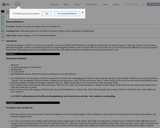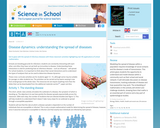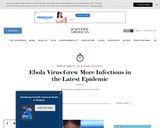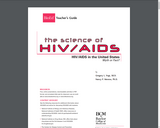
This parent guide supports parents in helping their child at home with the 8th grade Science content.
- Subject:
- Science
- Material Type:
- Reference Material
- Vocabulary
- Author:
- Kelly Rawlston
- Letoria Lewis
- Date Added:
- 10/11/2022

This parent guide supports parents in helping their child at home with the 8th grade Science content.

This resource accompanies our Rethink 8th Grade Science course. It includes ideas for use, ways to support exceptional children, ways to extend learning, digital resources and tools, tips for supporting English Language Learners and students with visual and hearing impairments. There are also ideas for offline learning.

In this activity, students read a scenario describing an outbreak of illness among fishermen working along the Eastern Shore of the Chesapeake Bay. Then students will describe and develop an investigation that could be conducted to resolve the issue.

In this lesson, students investigate epidemics and the spread of disease. Selected students, with certain characteristics in common, are given "DZ" signs representing a fictitious disease. Then students observe how the disease is distributed and develop hypotheses about what might have caused that "DZ" distribution.

In this lesson, students investigate epidemics and the spread of disease. Each student is assigned an exposure and, assuming the exposure causes a disease, writes a decription of how a hypothetical disease would be distributed in terms of person, place, and time. Students then review each other's descriptions and formulate one or more hypotheses for each. When students compare their hypotheses, they realize that a given distribution of a health-related outcome can lead to the formulation of several different educated guesses.

This card set has photos and information about some of the infectious diseases that CDC studies. You can view the set online OR download and print a hard copy. To view or print a hard copy set, you will need Adobe Acrobat Reader.

In this lesson, students simulate the spread of a disease and locate "patient zero." They will understand factors that affect the spread of disease and the challenges of epidemiology. Using common laboratory equipment, students will simulate the spread of a simple imaginery disease in order to explore infection and the difficulties of tracing the path of transmission.

These activities simulate disease outbreaks and how diseases spread.

In this lesson, students will learn about the scientific method and the characteristics of life by assuming the role of epidemiologists. The scenario that they will investigate is that many individuals in the school have recently become ill with gastrointestinal symptoms (vomiting, diarrhea, dehydration, and headache). Students will discover the source of the illness, the microbe causing the illness, and the biology behind the organism spreading the disease. By examining stool samples made from molasses and water, students will examine differences between affected and unaffected individuals. The students will eventually determine the source of the outbreak is contaminated water in the school cafeteria and conclude that the microbe involved is a bacterium called cholera. Students will then conclude the lesson by investigating an outbreak of birth defects.

In this activity, students read a scenario describing an outbreak of illness among people attending a national conference. Then students will describe and develop an investigation that could be conducted to resolve the issue.

In this mission-based lesson, students learn basic concepts about epidemiology in the context of the current outbreak and apply what they have learned to design a strategy to control the epidemic. A digital student guide is offered in conjunction with the lesson at: http://www.pbs.org/newshour/extra/lessons-plans/ebola-outbreak-mission-instructions-and-resources-digital-student-guide/

In this podcast, Christoper Intagliata reports about a strain that emerged during the latest epidemic and is able to enter human cells more easily - which means it's more infectious, too.

In this lesson, students will determine the agent and the source of the agent causing a hypothetical outbreak of diarrheal illness. The activity is modeled after the 1993 outbreak of Cryptosporidium infections that involved a public water system in Milwaukee. It provides opportunities for students to use analytical thinking skills to determine the cause of the outbreak.

In this lesson, students will use statistical tables of HIV/AIDS data to create presentations about occurrences of HIV/AIDS in the United States.

This video lesson explains how smart advances in vaccine design, production and distribution are bringing us closer than ever to eliminating a host of global threats -- from AIDS to malaria to flu pandemics. Assessment and discussion questions, as well as links to additional resources, are included.

In this lesson, students will take part in a scientific investigation of a 1993 hantavirus outbreak and learn how to prevent hantavirus infection.

This short video lesson describes the history of pandemics and how that knowledge can help halt future outbreaks. Assessment questions and links to additional resources are included.

This presentation is a supplemental resource to be used in conjunction with the lesson "I Have a Gut Feeling." This lesson plan demonstrates how surveillance can be used by epidemiologists to identify and define an outbreak or public health problem. Students will gain a basic understanding of public health surveillance terminology, systems, and applications. They also will have an opportunity to apply their knowledge in analyzing data from a case study of an outbreak of Escherichia coli infections. At the end of the lesson, students should have a stronger understanding of public health surveillance and its application in monitoring and ending outbreaks.

Students play a game that simulates the spread of an epidemic.

In this lesson, students are drawn into post-Revolutionary Philadelphia during the midst of the infamous yellow fever epidemic of 1793 by reading Laurie Halse Anderson's novel Fever 1793. Use this novel as supplemental reading to assist students in developing their understanding of and interest in colonial times, while heightening their reading skills and ability for higher order thinking.